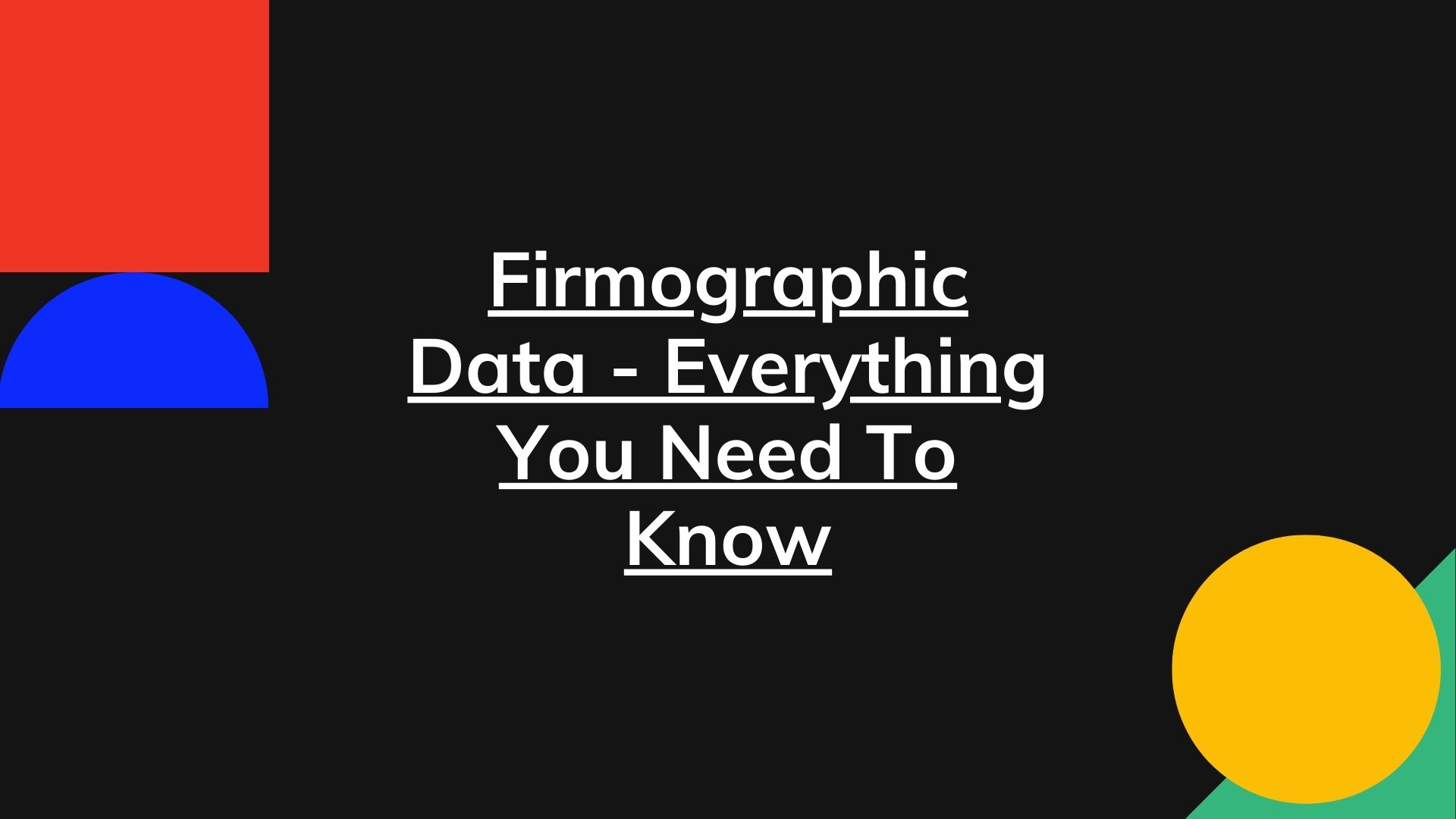If you’re trying to understand what exactly is firmographic data? How is it used and what benefits do they offer? We’ve got you covered.
In the age of information overload, getting your message to the right people and improving your reach as a business can be challenging. Data can help. Information about the employees working at the organization and the tech they use can improve sales and marketing performance. But what about firmographics? Businesses are using firmographics to segment organizations into categories, making it easier to reach the right people.
What is Firmographic Data?
Firmographic Definition: Data that describes an organization as a whole.
Data is what makes a marketing campaign successful. Understanding who you’re marketing to is crucial. Firmographic helps you do that. Think of it as demographics for organizations rather than everyday consumers.
Firmographic data can give you a lot of important information about an organization, including its:
- Size
- Industry
- Location
- Sales and revenue
- Growth
- Ownership framework (private, public or non-profit, etc.)
Additionally, firmographic and demographic segmentation can overlap when it comes to job titles, buying power and departments. This crossover segment can help you better understand the people who are responsible for decision-making within the company.
How Is Firmographic Data Used In Sales and Marketing?
When it comes to sales and marketing, firmographic data is used by B2B companies to segment the market and better identify potential clients. Firmographic data can help businesses get their message in front of the right people, which can make lead generation more effective.
Businesses use firmographic data to:
- Identify Qualified Leads: Firmographic data makes it easy to identify qualified leads that are more likely to convert to customers.
- Optimize Ad Targeting: Firmographic data can help you target the right people when running ads on social media or search engines. Taking a data-based approach to ad optimization ensures that your message is seen by decision-makers.
- To Improve Sales and Messaging: Firmographic data allows businesses to personalize their marketing and sales messages. Understanding the organization’s size, revenue growth, locations and other important information makes it easier to create more personalized messages that resonate with your target customers.
When used strategically, firmographic data can help businesses improve their sales and marketing performance.
Why Is Firmographic Data Used?
Businesses use firmographic data to segment customers and help create more personalized content for leads. When your sales and marketing teams have access to segmented data, they spend less time parsing through data and more time reaching out to the right people.
Firmographic segmentation offers many benefits for businesses, including:
Better Market Targeting
Having key information about B2B buyers, such as market size and revenue, can help businesses improve their market targeting.
A small or medium-sized business will require a different approach than a large enterprise, which is likely looking for a custom solution.
The more you know about an organization as a whole, the better you can tailor your marketing messages to resonate with the right people. If you don’t understand the potential needs and wants of an organization, it becomes more difficult to successfully personalize your messages and campaigns.
Better Customer Support
Firmographic data can give insight into how an organization is geographically distributed, which can help you improve your customer support. A multinational enterprise may prefer on-demand services, while a smaller entity may prefer a local provider.
Being able to cater to the customer service needs and wants of your target market can help not only improve conversions but also keep existing clients around.
Firmographic data can also help you understand the buying behavior of your clients and allow you to suggest other solutions that may meet their needs.
Firmographic Data Examples
The benefits and uses of firmographic data are clear, but how exactly is this data collected? Here are some common examples of how this data is gathered:
Purchase Data
One simple way to get firmographic data is to purchase it from a reliable vendor. Vendors have large databases of information that organizations can use along with other forms of data collection.
Some vendors may only offer access to limited relevant and up-to-date information, so it’s important to choose your vendor carefully.
Inferred Data
Businesses can obtain quite a bit of firmographic data by reviewing:
- Public reports
- Job listings
- Social media accounts
The inference method of data collection can be effective, but you’ll need a team of experts who can analyze the information carefully for accuracy and relevancy.
Self-reported Data
Another effective way to collect firmographic data is by contacting the company directly to request self-reported data. Companies will be more willing to provide this data if you can establish a positive rapport first. In-person meetings and phone calls can help get the ball rolling.
Research
Firmographic data can also be extracted online from company websites and government agencies. Although highly effective, research-related processes are time-consuming and ongoing. It’s often helpful to have a team of data analysts with industry expertise to extract relevant information.
Firmographic Data Vendors and Providers
Data vendors are available for nearly every niche and industry in the world. Through proper data sourcing, the potential leads of a business will be more refined and provide higher conversion rates.
A few of the many firmographic data vendors include:
Slintel B2B Data
Slintel is a leader in B2B data, and the platform offers numerous data points and filtering options to ensure that you receive the best firmographic data and more. The platform allows for filtering data based on:
- Location
- Revenue
- Company size
- Sector
- Technology
The platform offers data on 286 million contacts and 14.5 million companies. Even job data is available through Slintel to help further narrow down prospects.
People Data Labs
People Data Labs provides a multitude of B2B data as a popular B2B data provider, with:
- 3-billion-person profiles
- 18 million company profiles
Individual data includes resume, social media, demographic and contact information. Person and company data sets are available. APIs are available that allow development teams to integrate these data sources into existing platforms to make it easier for marketing teams and decision makers to use firmographic data with as little impact on existing workflows as possible.
Coresignal
Coresignal’s database includes more than 91 million company records from 10 firmographic sources. What makes this vendor stand out is the fact that they offer:
- Clean, parsed and updated data
- A variety of data points, including industry, size and performance
- JSON delivery
- The ability to map company locations via geographic data
Simply tell the team at Coresignal what you need, get your requested data and get regular updates (monthly or quarterly) to keep your data up to date. You can request a free data sample through the company’s website to get an idea of the quality and reliability of their data.
BoldData
BoldData takes a more personalized approach to firmographic data. The company’s firmographic database includes information for more than 341 million businesses across the world and is GDPR proof.
BoldData can provide more than 200 firmographics, including industry, size, legal, revenue, opening hours, geocodes and more. They use thousands of local data sources to create and maintain their database, and all data is verified both manually and through automated processes.
Rather than simply giving you access to their huge database, BoldData’s team of data experts works closely with clients to build highly targeted databases for each one based on:
- 200 firmographics
- 10,000 criteria
They provide free quotes within 24 hours to help inquiring businesses determine whether their service fits into their budget.
Other Firmographic Vendors
Firmographic Market Segmentation Explained
Market segmentation helps businesses market their products and services with greater efficiency. The right data provides insights into leads, which improves marketing efforts. Utilizing data in segmentation is a powerful tool to help target the right markets at the right time.
A few of the ways that firmographic market segmentation include:
Financial Data
Potential leads may be a better fit based on financial data, which includes:
- Revenue
- Profits
- Losses
- Growth potential
Segmenting data based on financial status will allow businesses to target fast-growing companies, or perhaps targeting leads with falling or stagnant revenue may make more sense.
Financial data segmentation provides insights into whether or not a business may benefit from the products or services that you’re offering.
Marketing campaigns can be built specifically around financial data. For example, a marketing campaign for a business that is losing sales will be much different from a campaign for a company that is struggling due to rapid growth.
Financial data can also be refined down further with the introduction of industry data.
Industry Data
Firmographic data can be segmented down to allow businesses to know more about the products and services a potential lead offers. Marketing professionals can use this information to optimize their leads, improve campaigns and reduce costs.
Instead of focusing on leads with low conversion potential, segmentation empowers teams to target leads through:
- Strategic industry data
- Removal of non-ideal clients
For example, if a business wants to target a cluster of leads in the animal industry, they can use industry segmentation to remove all leads but those that cater to dogs. Going further, segmentation can help narrow leads down into only companies that make products for Great Danes.
Location Data
Segmentation through location data is also very common, and it allows for highly targeted marketing campaigns. For example, it’s possible to segment data for major cities, such as New York and Miami.
Through segmentation, it’s possible to create unique marketing campaigns for geographic ranges.
For example, if a business sells trees to major retailers, they can segment datasets by location to market only trees that grow in certain regions to the appropriate businesses in that region.
Organizational Data
Next, organizational data will come into the segmentation mix, and this is data that is extremely effective in marketing. Analysts can use this data in numerous ways to better understand a business’s hierarchy.
For example, marketing teams may take firmographic data sets and decide to narrow down this data based on organizational structure. So, the marketing team may decide to target the right individuals to have relationships with, such as:
- Buyers, who are always scouring the market for new, exciting products
- Marketing leads, who may need their product or service to improve sales
- Owners who are trying to find ways to alleviate pain points
Organizational data becomes even more important for segmentation when dealing with massive enterprises. When hundreds or thousands of potential employees exist in an organization, it can be difficult to reach the right decision maker without segmenting data on the organizational level.
Size Data
Size data will give insight into the size of the organization. Knowing the size of the business, whether small or a large enterprise, will allow you to take the right marketing approach.
Several data points can be used to determine the size of the business, including:
- The number of employees
- Revenue
- The physical size of the organization (building size)
- Global reach
Number of employees and revenue are the two main indicators and can help break down businesses into the following categories:
- Micro-enterprise: Fewer than 10 employees with revenue of around $2 million
- Small enterprise: Fewer than 50 employees with revenue of around $12 million
- Medium enterprise: Fewer than 250 employees with revenue of around $60 million
- Large enterprise: Greater than 250 employees with revenue of greater than $60 million
When you understand the size of the organization, both in terms of workforce and revenue, you can better target the right businesses.
Segmentation helps business leads make sense of data to target leads with great precision.
Firmographic Data Vs Technographic Data
Firmographic data should be clear to anyone who has read our guide to this point. You’ll use this data to learn more about companies and organizations that you plan to market to or do business with.
However, there are many different forms of data that will provide valuable information to marketing and sales teams:
- Firmographic
- Technographic
- Demographic
- Etc.
For the purpose of this section, technographic data is the most important. This information is all about a company’s tech stack. For example, Microsoft may collect data on businesses in a certain industry, such as automotive, to learn more about their tech stack.
If a potential lead has the right tech stack, the marketing team at Microsoft will decide to market to them and try offering a solution to solve their problems.
Technographic data doesn’t provide in-depth insight into a business, but it will help you learn:
- Which software the company is already using
- Holes in the tech stack that you may be able to fill
When using technographic data, the main point is to create custom campaigns that rely on the data at hand. Marketing teams will often use this data for a few reasons:
- Segmentation. Tech stacks provide a lot of information about businesses, and they will help your business segment data to a new level of efficiency. Technographic stacks will help businesses know what a company is already spending on their tech stack and what they may be willing to spend in the future.
- Account-based marketing. Sales representatives can target accounts with greater accuracy by understanding the motives of companies choosing certain products. When you know a company’s tech stack, it’s possible to pitch your product better to improve sales ratios.
- Improved campaigns. Creating news-driven campaigns improves dramatically when you can highlight certain product features that touch on the business’s pain points and cater product releases based on potential tech stacks.
Combining both technographic and firmographic data into one will provide the best results in the marketing industry. Targeting accounts with both forms of data makes sense because it’s easier to reach prospects and meet their needs.
Well-informed decisions are data-driven, and both data sets empower businesses to create marketing campaigns and target the right leads with high precision. In B2B marketing, the right data can mean the difference between making sales and losing money.
Firmographic data will lead teams to target the right companies to contact, while technographic data will help narrow down large lists for better results.
Marketing teams can use this data to:
- Target the right accounts
- Create highly optimized marketing campaigns
- Build out customized content marketing plans
However, there are other datasets available that will provide greater insights, such as demographic data.
Firmographic Data vs Demographic Data
In marketing, firmographic data is crucial to knowing your audience. Sales and marketing strategies should revolve around smart data choices. Two main types of data that you’ll come across are:
- Firmographic data
- Demographic data
Demographic data will always remain an important part of marketing and sales. When marketers collect demographic data, they’re learning about people rather than about an organization or company.
For example, the data would include:
- Age
- Income
- Religion
- Occupation
- Education level
- Gender
- Etc.
As we’ve seen, firmographic data will include data points on an industry, location of a company, size, type and other information.
If a business is focusing primarily on B2C, they’ll find that demographic data may be the better choice for their marketing and sales needs. However, if you’re focusing on B2B sales, there’s no denying that firmographic data is going to be more valuable.
Firmographic data is crucial in a business’s marketing and sales strategies. Knowing as much information about a potential customer will make it easier to sell to them.



